Non-coding DNA, also known as “junk DNA,” has been discovered to be anything but harmless and inactive and may even play a role in the onset of cancer.

Image Credit: The Institute of Cancer Research
Their research has demonstrated how non-coding DNA might obstruct the human genome’s replication and repair processes, potentially causing mutations to build up.
The replication of the genome has been revealed to be susceptible to disruption by non-coding or repetitive DNA patterns, which make up around half of the human’s genome.
However, researchers do not yet fully comprehend the underlying mechanism or how it can influence the onset of cancer.
Reconstituting DNA replication in a test tube
To better comprehend DNA replication, researchers at The Institute of Cancer Research, London, recreated the entire process in a test tube for the new study.
The ability of the researchers to explain how repeated DNA patterns can completely block DNA replication and increase the likelihood of mistakes, which can act as a precursor to cancer, allowed them to explain how repetitive DNA patterns are copied during DNA replication. This important information could eventually result in improved medications and therapies.
The findings, in the opinion of the researchers, may also aid in improving the diagnosis and follow-up of some tumors, such as bowel cancer, where frequent faults in the replication of repetitive DNA sequences signal whether cancer is advancing.
The Institute of Cancer Research (ICR) provided further support for the study, which was supported by Wellcome and the Royal Society and published in Nature Communications.
DNA replication errors trigger damage response
Researchers from the ICR, a nonprofit research and educational organization, discovered that the DNA replication machinery could unwind repetitive DNA strands but occasionally failed to replicate the opposite DNA strand. The replication mechanism may fail as a result of this error, much like how DNA damage causes the replication process to collapse.
According to the research, repeated DNA patterns can cause a damage response signal, which would indicate that errors in DNA replication have occurred and need to be fixed.
The study further supports the association between junk DNA and cancer, which is known to increase cancer formation and progression due to DNA damage and the resulting genome instability.
The first concrete proof that DNA damage is the underlying cause of cancer was offered in the 1960s by researchers at the ICR. ICR researchers later showed that tumors with DNA repair defects may be genetically targeted with medications known as PARP inhibitors in the early 2000s.
Now, the experts are hoping that a better comprehension of DNA replication and how it might go awry will result in novel strategies to treat the condition.
Junk DNA plays an important role
We wanted to understand why it seems more difficult for cells to copy repetitive DNA sequences than other parts of the genome. Our study suggests that so-called junk DNA is actually playing an important and potentially damaging role in cells, by blocking DNA replication and potentially opening the door to cancerous mutations.”
Dr Gideon Coster, Study Leader and Team Leader, Genome Replication, Institute of Cancer Research
“We now believe that repetitive DNA sequences trigger a response that is very similar to the one induced by DNA damage, which we know can lead to cancer. Our study therefore fundamentally advances our understanding of cancer, and I’m hopeful it will help us come up with new treatments in the future.”
Exploiting fundamental weaknesses in cancer
This study helps to unravel the puzzle of junk DNA—showing how these repetitive sequences can block DNA replication and repair. It’s possible that this mechanism could play a role in the development of cancer as a cause of genetic instability—especially as cancer cells start dividing more quickly and so place the process of DNA replication under more stress.”
Kristian Helin, Professor, Chief Executive, Institute of Cancer Research
“Understanding the mechanisms underlying genetic mutation and instability is critical if we are to find innovative new ways to treat cancer that exploit fundamental weaknesses in cancer cells.”
Source:
Journal reference:
Casas-Delucchi, C. S., et al. (2022) The mechanism of replication stalling and recovery within repetitive DNA. Nature Communications. doi.org/10.1038/s41467-022-31657-x.